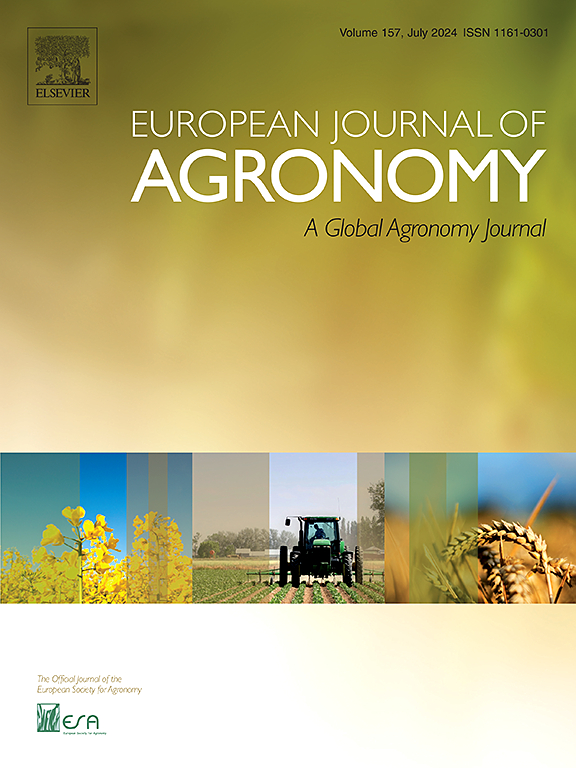大气氨浓度升高下,优化氮肥通过调节冠根性状和光合作用提高小麦产量
IF 4.5
1区 农林科学
Q1 AGRONOMY
引用次数: 0
摘要
大气氨(NH3)浓度升高条件下,作物生长和产量形成对施氮的响应尚不清楚。我们推测,NH3浓度升高和不同施氮量可能通过调节冠根性状和光合能力影响小麦产量。为此,进行了为期3年的野外试验,以阐明不同NH3浓度(大气NH3: 0.03 ± 0.01 mg m−3,ANH3;NH3(0.30 ± 0.05 mg m−3,ENH3)和施氮量(0、150和225 kg N ha−1,分别表示为N0、N1和N2)对冬小麦冠层和根系生长、光合能力和生产力的影响。结果表明,与ANH3处理相比:(1)EN1、150 kg N ha−1处理对冬小麦地上、地下生长均有较好的调控作用。这导致了较低的根冠比(R/C),刺激了地上生物量和氮素积累,最终使籽粒产量提高4.2 −6.5 %,氮肥部分生产力提高3.3 −7.5 %;(2)处理ENH3提高了叶面积指数(LAI) 3.2 −5.3 %,净光合速率(Pn) 3.1 −5.8 %,相对叶绿素含量(SPAD) 3.6 −8.1 %,有助于保持较高的冬小麦源活性。ENH3处理使源容量提高5.4 −8.4 %,源汇比提高3.2 −4.7 %。与EN1处理相比,EN2处理使R/C比提高了2.8 −4.5 %,粒数/叶比(KNL)和粒重/叶比(KWL)分别降低了8.1 −10.7 %和4.7 −7.2 %,最终使籽粒产量降低11.8 −14.4 %。总体而言,在高铵环境下,施氮量150 kg N ha−1通过调节冠根性状和建立新的源库平衡提高了小麦产量。本研究为未来NH3升高环境下小麦化学氮用量减少的可能性提供了有价值的科学见解。本文章由计算机程序翻译,如有差异,请以英文原文为准。
Optimizing nitrogen fertilization to enhance wheat productivity by regulating canopy-root traits and photosynthesis under elevated atmospheric ammonia concentration
The response of crop growth and yield formation to nitrogen (N) application under elevated atmospheric ammonia (NH3) concentrations remains unclear. We hypothesize that elevated NH3 concentrations combined with different N application rates would affect wheat productivity through regulating canopy-root traits and photosynthetic capacity. Therefore, a three-year field experiment was conducted to clarify the effects of different NH3 concentrations (atmospheric NH3: 0.03 ± 0.01 mg m−3, ANH3; elevated NH3: 0.30 ± 0.05 mg m−3, ENH3) and nitrogen application rates (0, 150 and 225 kg N ha−1, denoted as N0, N1 and N2, respectively) on canopy and root growth, photosynthetic capacity, and winter wheat productivity. The results indicated that compared to the ANH3 treatment: (1) ENH3 treatment (EN1, 150 kg N ha−1) effectively regulated both above- and below-ground growth of winter wheat. This resulted in a lower root-canopy (R/C) ratio, stimulating aboveground biomass and nitrogen accumulation, which ultimately increasing grain yield by 4.2 −6.5 % and partial productivity of nitrogen fertilizer (NPFP) by 3.3 −7.5 %; (2) ENH3 treatment increased leaf area index (LAI) by 3.2 −5.3 %, net photosynthetic rate (Pn) by 3.1 −5.8 % and relative chlorophyll content (SPAD) by 3.6 −8.1 %, which helped maintain higher source activity in winter wheat. ENH3 treatment increased source capacity by 5.4 −8.4 % and source-sink ratio by 3.2 −4.7 %. Compared to the EN1 treatment, EN2 treatment increased the R/C ratio by 2.8 −4.5 %, and both kernel number/leaf ratio (KNL) and kernel weight/leaf ratio (KWL) decreased by 8.1 −10.7 % and 4.7 −7.2 %, ultimately decreasing grain yield by 11.8 −14.4 %. Overall, N rate of 150 kg N ha−1 under elevated NH3 environment improved wheat yield by regulating canopy-root trait and establishing new source-sink balance. This study provides valuable scientific insights into the potential reduction of chemical N use for wheat production in future elevated NH3 environment.
求助全文
通过发布文献求助,成功后即可免费获取论文全文。
去求助
来源期刊

European Journal of Agronomy
农林科学-农艺学
CiteScore
8.30
自引率
7.70%
发文量
187
审稿时长
4.5 months
期刊介绍:
The European Journal of Agronomy, the official journal of the European Society for Agronomy, publishes original research papers reporting experimental and theoretical contributions to field-based agronomy and crop science. The journal will consider research at the field level for agricultural, horticultural and tree crops, that uses comprehensive and explanatory approaches. The EJA covers the following topics:
crop physiology
crop production and management including irrigation, fertilization and soil management
agroclimatology and modelling
plant-soil relationships
crop quality and post-harvest physiology
farming and cropping systems
agroecosystems and the environment
crop-weed interactions and management
organic farming
horticultural crops
papers from the European Society for Agronomy bi-annual meetings
In determining the suitability of submitted articles for publication, particular scrutiny is placed on the degree of novelty and significance of the research and the extent to which it adds to existing knowledge in agronomy.
 求助内容:
求助内容: 应助结果提醒方式:
应助结果提醒方式:


